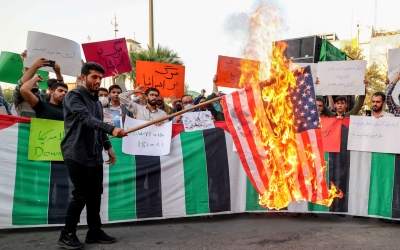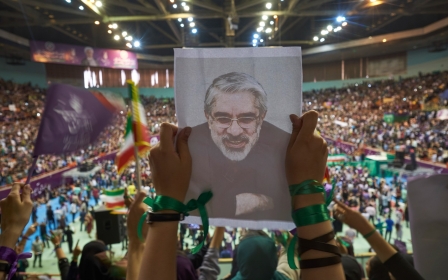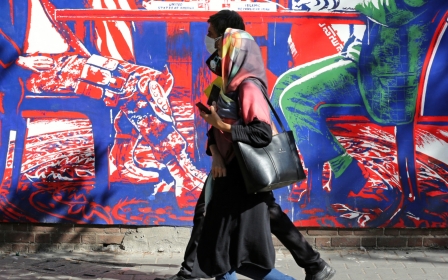Iranian press review: Concerns rise over Iran-Azerbaijan military confrontation

Azerbaijan border tensions
Iran's army, Artesh, and the Islamic Revolutionary Guard Corps (IRGC) forces have increased their military presence on the country's northwestern borders as tensions rise between Azerbaijan and Armenia.
On 23 March, local media released an unconfirmed video of fighter jets manoeuvring in the sky, saying that Iranian F4 and F14 fighter jets flew close to the border with Azerbaijan to warn Baku about any new military operation in the breakaway province of Nagorno-Karabakh, a region populated mainly by ethnic Armenians but claimed by Azerbaijan.
That same day, Fars news agency reported that Brigadier General Mohammad Pakpour, the commander of the IRGC ground forces, visited the troops guarding Iran's borders with its two northwestern neighbours, Armenia and Azerbaijan.
Meanwhile, Iranian analysts began speculating about Tehran's potential response to a new military confrontation between Baku and Yerevan over Nagorno-Karabakh.
New MEE newsletter: Jerusalem Dispatch
Sign up to get the latest insights and analysis on Israel-Palestine, alongside Turkey Unpacked and other MEE newsletters
The Fararu website suggested that Iran would provide more support to Armenia in the event of a new war in the region. According to Fararu, Tehran would support Armenia with logistical assistance and military aid to stop Azerbaijan from gaining more territory in the disputed zone.
The Nameh News was another website that wrote about a potential military confrontation between Tehran and Baku if a new conflict began in Nagorno-Karabakh.
"In a new war, if Azerbaijan defeated Armenia, we would witness [more] tensions between Iran and Azerbaijan. In the first phase, these tensions would occur in political, economic and cultural fields, and if they continued, they would enter the military phase," wrote Nameh News.
Since the 2020 Nagorno-Karabakh conflict, the political relations between Tehran and Baku have deteriorated, while Azerbaijan increased military ties with Israel.
Iranians demand protests death toll
Over six months after the nationwide protests that rocked Iran after the death of 22-year-old Mahsa Amini in police custody, officials have failed to announce the exact number of protesters and security forces who died in the clashes.
On 9 January, when the security services and the Islamic Revolutionary Guard Corps cracked down on the last large-scale protests in the country, the Norway-based organisation Iran Human Rights reported that at least 481 protesters had been killed during the 2022 uprising.
However, the number of security and IRGC forces killed during the protests is unclear.
On 28 March, the Ensaf News website, under the headline: "The mystery of the martyrs of security", urged authorities to release the number of deaths among forces which took part in suppressing the protests.
"Martyrs of security" is the term the officials use for security forces killed during the protests.
"One hundred days have passed without any major protest in the country, but still, there are several serious questions and ambiguities about the number of deaths during the protests," wrote Ensaf News.
The article underlined the conflicting numbers announced by officials and asked about a confirmed death toll of security forces.
"On 10 December, it was said that 53 martyrs of troops who dedicated their lives to the revolution and the establishment…Sixty days later, the country's prosecutor general said over 90 security and Basij forces were killed…and the foreign minister in a challenging interview with [CNN's] Christiane Amanpour raised the number to 'over 100'," said the news site.
In the 2022 uprising, authorities deployed regular police officers, the police's special units, the Basij paramilitaries, the IRGC forces and intelligence officers to suppress the anti-establishment protests.
Anti-hijab trend 'is like coronavirus'
A conservative cleric, Ayatollah Mohsen Araki, threatened Iranians who defy the mandatory Islamic hijab law with severe punishment, saying that spreading anti-hijab thoughts is akin to the coronavirus.
"The increasing number of unveiled women means the spread of [moral] corruption; this is as if the killer coronavirus is spreading in society," Eslahat News quoted Araki as saying on Monday.
"We should seriously fight against this new disease because the coronavirus that is rapidly contaminating the Islamic society is the virus of unveiled women.
"No veiling means promoting unlawful sexual exploitation of women in society…and we will not let this happen in [our] Islamic society."
Araki, who was born and raised in Iraq, is a conservative cleric close to Iran's supreme leader. He holds seats in two influential organisations in Iran, the Assembly of Experts for Leadership and the Expediency Discernment Council.
After the brutal crackdown on the 2022 protests, conservative clerics and hard-line politicians have urged the government to fully implement the mandatory hijab law.
The demonstrations began in September in protest of the hijab law after the death of Mahsa Amini, a young Kurdish girl, in morality police custody after she was detained for not covering her hair "properly".
*Iranian press review is a digest of news reports not independently verified as accurate by Middle East Eye.
Middle East Eye delivers independent and unrivalled coverage and analysis of the Middle East, North Africa and beyond. To learn more about republishing this content and the associated fees, please fill out this form. More about MEE can be found here.






